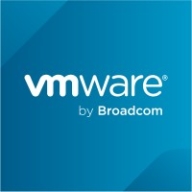

Find out in this report how the two Cloud Software Defined Storage solutions compare in terms of features, pricing, service and support, easy of deployment, and ROI.
Starting with a smaller infrastructure and scaling as required allows us to save costs initially.
I have seen a return on investment; it's satisfactory in the long run.
I would rate their support nine points.
I am not satisfied with VMware support, particularly with the reaction times, SLAs, and those kinds of issues.
If we consider technical support from Broadcom, I would rate them an eight or nine now.
It wouldn't help with outages either; the scaling is manual, and there are no processes we've used to automate that for unexpected scenarios.
It supports up to 64 nodes in a cluster, allowing us to add nodes and expand the cluster as needed.
If you have already bought it, you need specific servers, and it is easier with a SAN.
When setting up a new installation, it is relatively stable.
In terms of stability, I give VMware vSAN nine points.
It would be nice to see technology supporting the Elastic Fabric Adapter on Amazon AWS, therefore getting RDMA technology for more low-latency connections.
My opinion is that support is generally very good. There are instances where they take longer to respond or resolve issues, especially when customers have urgent needs, but ultimately, resolution is achieved.
I have recently used Nutanix, and I observed that Nutanix provides better performance than VMware vSAN due to its data locality features.
Discussing the pricing model is significant as Broadcom creates many discussions worldwide regarding pricing.
A proper monitoring tool that encompasses both applications and infrastructure would help in quickly resolving issues.
This has resulted in a slight cost increase.
The granular ability to divide up the performance and the amount of storage you want is really fantastic.
Hot add features are available by default in vSphere, allowing us to immediately increase memory, CPU, and hard drive without any downtime.
The performance is excellent, handling workloads better than direct-attached or legacy storage solutions.
Everything is integrated, allowing for more automation and ease of use.


| Company Size | Count |
|---|---|
| Small Business | 8 |
| Midsize Enterprise | 11 |
| Large Enterprise | 53 |
| Company Size | Count |
|---|---|
| Small Business | 100 |
| Midsize Enterprise | 58 |
| Large Enterprise | 129 |
NetApp Cloud Volumes ONTAP is an efficient storage management solution for managing and storing data in the cloud. It offers seamless integration with cloud providers, advanced data replication capabilities, and high data protection. With reliable performance, it is ideal for industries like healthcare and finance.
VMware vSAN is a software-defined storage product that is used in collaboration with VMware ESXi hypervisor and that provisions and manages storage based on policies, regardless of the underlying hardware. The solution enables you to prime your business for growth through its seamless evolution (it is integrated with vSphere and requires no new tools), its flexibility, and its multi-cloud capabilities. As an industry-leading software, VMware vSAN provides high levels of performance with minimal impact on CPU and memory.
VMware vSAN Features
VMware vSAN has many valuable key features. Some of the most useful ones include:
VMware vSAN Benefits
There are many benefits to implementing VMware vSAN. Some of the biggest advantages the solution offers include:
Reviews from Real Users
Below are some reviews and helpful feedback written by PeerSpot users currently using the VMware vSAN solution.
PeerSpot user Yves S., CEO, Cloud Evangelist at Comdivision Consulting GmbH, says, “vSAN gives us a lot of advantages when we need to expand resources. We have an overall larger host infrastructure, and we split that up for specific customer test and use cases. In that specific scenario, we can easily add more hosts or reduce the number of hosts in the environment.”
A reviewer who works in Infrastructure Security explains, “The ease of use is great. The initial setup and upgrade process was pretty straightforward. And, technical support is great.”
Laurent N., Director at Softlogic, comments, "The feature that I have found most valuable is that it is easy to deploy. It is easy to create and delete virtual servers. It is easy to create the load balancing and the clustering."
We monitor all Cloud Software Defined Storage reviews to prevent fraudulent reviews and keep review quality high. We do not post reviews by company employees or direct competitors. We validate each review for authenticity via cross-reference with LinkedIn, and personal follow-up with the reviewer when necessary.